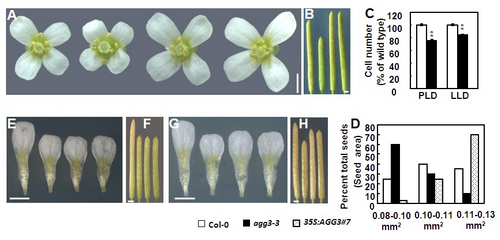Plant seed and organ size is an important agronomic trait. Control of final seed and organ size is also a fundamental key question in developmental biology. However, the genetic and molecular mechanisms that set the final size are largely unknown.
Scientists in Dr. Yunhai Li’s group from the Institute of Genetics and Developmental Biology, the Chinese Academy of Sciences characterized the function of heterotrimeric G protein γ subunit AGG3 on seed and organ size control in Arabidopsis. Loss of AGG3 function caused small organs with less cells, whereas overexpression of AGG3 produced large seeds and organs with more cells. In addition, they cloned and identified the homolog in Brassica (BrAGG3), which also promotes seed and organ growth. Their findings suggest the potentiality of AGG3 and its homologs in crop improvement. Genetic analyses revealed that AGG3 action requires a functional G protein α subunit (GPA1) and G protein β subunit (AGB1). Their results reveal that G-protein signaling is involved in seed and organ size control in plants.
This work with Shengjun Li and Yaju Liu as the co-first authors has been online published on New Phytologist (DOI: 10.1111/j.1469-8137.2012.04083.x). This research was supported by National Basic Research Program of China and National Natural Science Foundation of China.
AUTHOR CONTACT:
Yunhai Li, Ph.D.
Institute of Genetics and Developmental Biology, Chinese Academy of Sciences, Beijing, China.
(Image by Shengjun Li)
Figure. AGG3 controls seed and organ size. (A) Flowers of Columbia (Col-0), agg3-3, 35S:AGG3#6, and 35S:AGG3#7 transgenic lines (from left to right). 35S:AGG3 is the wild type (Col-0) transformed with the wild-type G protein γ subunit (AGG3) CDS driven by the 35S promoter. (B) Fruits of Col-0, agg3-3, 35S:AGG3#6, and 35S:AGG3#7 transgenic lines (from left to right). (C) The number of epidermal cells in the petal-length direction (PLD) (n > 20) and the number of palisade cells in the leaf-length direction (LLD) (n > 10). (D) Projective seed area of Col-0, agg3-1, and 35S:AGG3#7 transgenic plants (n > 80). The seeds were classified into three groups (0.08–0.10, 0.10–0.11, and 0.11–0.13 mm2). Values for each group are expressed as a percentage of the total seed number analyzed. (E, F) Petals (E) and fruits (F) of Col-0, agg3-3, agb1-2, and agb1-2 agg3-3 (from left to right). (G, H) Petals (G) and fruits (H) of Col-0, agg3-3, gpa1-101, and gpa1-101 agg3-3 (from left to right). Bars, 1mm. **P < 0.01, Student’s t-test).
 (Image by Shengjun Li)Figure. AGG3 controls seed and organ size. (A) Flowers of Columbia (Col-0), agg3-3, 35S:AGG3#6, and 35S:AGG3#7 transgenic lines (from left to right). 35S:AGG3 is the wild type (Col-0) transformed with the wild-type G protein γ subunit (AGG3) CDS driven by the 35S promoter. (B) Fruits of Col-0, agg3-3, 35S:AGG3#6, and 35S:AGG3#7 transgenic lines (from left to right). (C) The number of epidermal cells in the petal-length direction (PLD) (n > 20) and the number of palisade cells in the leaf-length direction (LLD) (n > 10). (D) Projective seed area of Col-0, agg3-1, and 35S:AGG3#7 transgenic plants (n > 80). The seeds were classified into three groups (0.08–0.10, 0.10–0.11, and 0.11–0.13 mm2). Values for each group are expressed as a percentage of the total seed number analyzed. (E, F) Petals (E) and fruits (F) of Col-0, agg3-3, agb1-2, and agb1-2 agg3-3 (from left to right). (G, H) Petals (G) and fruits (H) of Col-0, agg3-3, gpa1-101, and gpa1-101 agg3-3 (from left to right). Bars, 1mm. **P < 0.01, Student’s t-test).
(Image by Shengjun Li)Figure. AGG3 controls seed and organ size. (A) Flowers of Columbia (Col-0), agg3-3, 35S:AGG3#6, and 35S:AGG3#7 transgenic lines (from left to right). 35S:AGG3 is the wild type (Col-0) transformed with the wild-type G protein γ subunit (AGG3) CDS driven by the 35S promoter. (B) Fruits of Col-0, agg3-3, 35S:AGG3#6, and 35S:AGG3#7 transgenic lines (from left to right). (C) The number of epidermal cells in the petal-length direction (PLD) (n > 20) and the number of palisade cells in the leaf-length direction (LLD) (n > 10). (D) Projective seed area of Col-0, agg3-1, and 35S:AGG3#7 transgenic plants (n > 80). The seeds were classified into three groups (0.08–0.10, 0.10–0.11, and 0.11–0.13 mm2). Values for each group are expressed as a percentage of the total seed number analyzed. (E, F) Petals (E) and fruits (F) of Col-0, agg3-3, agb1-2, and agb1-2 agg3-3 (from left to right). (G, H) Petals (G) and fruits (H) of Col-0, agg3-3, gpa1-101, and gpa1-101 agg3-3 (from left to right). Bars, 1mm. **P < 0.01, Student’s t-test). CAS
CAS
 中文
中文




.png)
